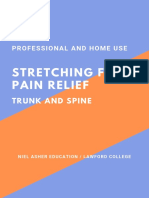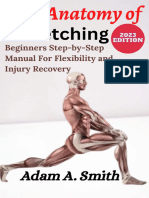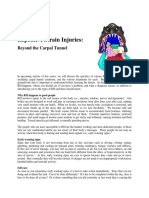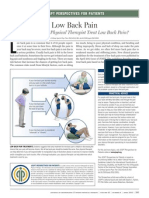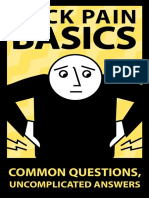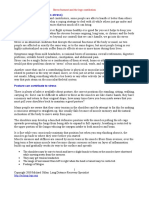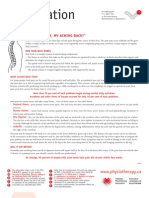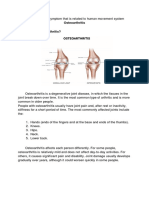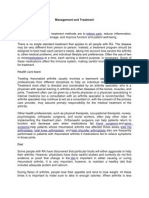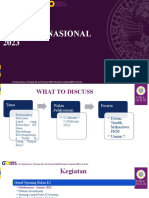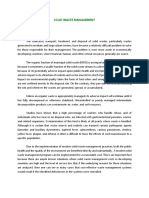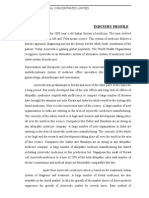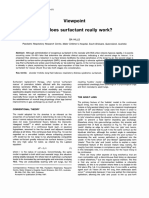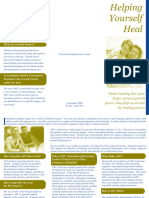Spasticity
Spasticity
Uploaded by
Veny AjrinaCopyright:
Available Formats
Spasticity
Spasticity
Uploaded by
Veny AjrinaOriginal Description:
Copyright
Available Formats
Share this document
Did you find this document useful?
Is this content inappropriate?
Copyright:
Available Formats
Spasticity
Spasticity
Uploaded by
Veny AjrinaCopyright:
Available Formats
Spasticity and spasms
Spirella Building, Letchworth, SG6 4ET 01462 476700 www.mstrust.org.uk reg charity no. 1088353
We hope you find the information in this factsheet helpful. If you would like to
speak with someone about any aspect of MS, contact the MS Trust
information team and they will help find answers to your questions.
This factsheet has been provided free by the Multiple Sclerosis Trust, a small
UK charity which works to improve the lives of people affected by MS. We rely
on donations, fundraising and gifts in wills to be able to fund our services and
are extremely grateful for every donation received, no matter what size.
MS Trust information service
Helping you find the information you need
The MS Trust offers a wide range of publications, including a newsletter Open
Door, which provides an ongoing update on research and developments in
MS management. In addition it contains articles from people with MS and
health professionals.
For a full list of MS Trust publications, to sign up for Open Door and much
more visit our website at www.mstrust.org.uk
Freephone 0800 032 3839 (Lines are open Monday Friday 9am-5pm)
email infoteam@mstrust.org.uk
write MS Trust
Spirella Building
Letchworth Garden City
SG6 4ET
1
Spasticity and spasms
Date of issue: July 2011
This factsheet will be reviewed within three years
Contents
1. What are spasticity and spasms? 1
2. Managing spasticity and spasms 4
3. Getting the most from medication 6
4. Measuring the impact of treatment 10
5. References 11
Spasticity and spasms are symptoms often associated with multiple sclerosis.
However, to ensure people with MS and health professionals communicate
effectively, it is vital to appreciate what the terms spasticity and spasms
describe as misunderstandings can occur. For instance, someone might
describe their symptom as a 'spasm', using the term to mean a sudden wave
of pain, where a health professional would understand the word to mean a
sharp contraction of a muscle. Unless the meaning is properly explored and
any confusion resolved between the popular use of a word and its medical
definition, it could lead to a doctor prescribing medication that will have little or
no effect on the individual's symptom.
1. What are spasticity and spasms?
Spasticity can be described as involuntary muscle stiffness and spasms as
involuntary muscle contractions. Any muscle can be affected but spasticity
and spasms tend to predominantly affect a person's limbs or trunk.
People with spasticity describe their muscles as feeling stiff, heavy and
difficult to move. When very severe it can be very difficult to bend a limb at all.
If a limb becomes fixed in one position it is known as a contracture.
2
Different types of spasm
1
Spasms
Flexor spasms
The limb bends upwards towards the
person's body
Extensor spasms
The limb extends away from the
person's body
Adductor spasms
The limb pulls inwards towards the
person's body. Commonly a person
experiences this as difficultly
separating their thighs
Spasms affecting the trunk
The back or trunk can arch off a bed
or away from the back of a chair
Why these symptoms occur
Nerve pathways connecting the brain, spinal cord and muscles, work together
to coordinate movements of the body. These pathways can be disrupted in
multiple sclerosis and can lead to loss of coordination, over-activity and / or
weakness of muscles.
Spasticity and spasms can range from mild to severe and can vary over time,
even throughout one day. People can describe the symptoms as annoying,
uncomfortable and unpredictable, although they can also be helpful. Some
people use the stiffness of their spasticity or extensor spasms to assist them
when walking or in transferring from bed to chair.
3
Other associated symptoms
Other features that may be associated with spasticity and spasms can include
pain, weakness and clonus.
Pain
Spasticity and spasms are not always painful. If pain is present it can be
described as a 'tugging' of the muscles and can be as a direct result of the
sudden spasm movement or the constant feeling of stiffness. Sometimes
spasticity and spasms can lead to altered sitting and lying positions which
can also lead to pain and discomfort.
Weakness
Although a limb with spasticity is stiff and can resist movement, some of
the muscles may also be weak. It can seem paradoxical to have some
muscles that are stiff and others that are weak, but this results from
different nerve pathways being disrupted. The co-existence of spasticity
and weakness can be challenging to manage as drugs can minimise
spasticity but not weakness. Sometimes when a person's stiffness is
reduced they feel their existing weakness is more prominent.
The feeling of weakness is often described by people with the term
'heavy'. Confusingly this word can also be used to describe stiff limbs.
To assess whether the heaviness is from weakness or spasticity, it may be
necessary for the health professional to bend and straighten the limb. This
is described as 'moving the limb through its full range of motion'. A limb will
resist being moved if spasticity is present. If weakness is present, although
it may feel cumbersome and weighty, the limb will move more easily.
Clonus
This is a repetitive, up and down movement, often of the feet. It is often
observed as a constant tapping on wheelchair footplates. Individuals often
find their own ways to minimise this symptom such as lifting the limb, or
leaning forward in the chair to pass weight through the leg.
Fatigue and loss of dexterity can also be associated with spasticity.
4
What is tone?
Spasticity is sometimes described as increased muscle tone. Muscle tone is
the resistance felt when an arm or leg is moved or stretched. Normal tone
occurs when an individual is relaxed and the health professional can bend
and straighten the limb without difficulty. An increase in tone can be due to
spasticity, spasms and or changes in muscles, tendons and ligaments as a
result of disuse, or altered lying and sitting postures.
2. Managing spasticity and spasms
Managing spasticity and spasms is a balance between minimising the
negative aspects and maintaining their usefulness, such as providing support
to weak muscles. Key to any long-term management plan is the need for
movement or stretching and the ongoing management of trigger factors.
Movement and stretching
It is important to keep muscles, ligaments and joints as flexible as possible.
This can be done through stretching, active movement (where the individual
moves their own limbs) or passive movement (where limbs are moved by a
physiotherapist or automated exercise machine). A physiotherapist can advise
on how to maintain flexibility, teach specific stretches, and ways of moving
and positioning the body to prevent contractures.
Similarly it is important to maintain good sitting and lying postures. This can
be assisted by adapting equipment such as wheelchairs and using aids to
improve sleep positions. Experts who can advise include specialist seating
services, physiotherapists and occupational therapists.
Optimising sitting postures
1
Poor positioning in sitting Good positioning in sitting
Hips and bottom at the back of the
seat, knees and feet at right angles
See also Are You Sitting Comfortably..?, the MS Trust's book on posture when sitting.
5
What can be done and who can help
Whether symptoms are mild or severe, medical, physiotherapy, nursing and
occupational therapy treatment, advice and education can help increase
understanding of spasticity. Increasing knowledge about spasticity and what
triggers it can help people manage it more effectively and prevent symptoms.
Certain factors are known to exacerbate spasticity and spasms.
Trigger factors
1
Who can give management advice
Urinary infection or
retention
Bowel impaction,
constipation, infection
Red or broken
skin/pressure areas,
ingrown toenails
Sometimes spasticity and spasms become
harder to manage; a review of bladder,
bowel and skin care management
techniques may improve the situation.
A GP, nurse specialist, continence advisor
and / or district nurse can give advice and
assistance to effectively manage bladder,
bowel and skin.
Pain
Infections
Pain and infection will aggravate spasticity.
Locating and treating the source of the pain
or infection eg skin infection or an ingrown
toenail, may reduce the spasticity. Advice
can be sought from a GP or district nurse.
Tight fitting clothes or
splints
Simply loosening tight garments may help
to relieve spasticity. If splints are causing
discomfort or skin irritation then they will
need reviewing by an orthotic or therapy
service.
In summary, the ongoing need to incorporate movement, stretching and good
sitting and lying postures together with managing trigger factors cannot be
over emphasised. However, sometimes it is necessary to complement these
strategies with the use of drugs.
6
3. Getting the most from medication
The effective use of drugs can be an invaluable part of how a person
manages their spasticity. When commencing any drug it is best to start with a
low dose and gradually increase it, until a level is reached that helps the
symptom but has minimal side effects. The oral drugs available (listed below)
can be used in combination, but usually a doctor will maximise the effect of
one drug before prescribing it with others. The doses indicated are only a
guide. A doctor will recommend the dose of specific drugs and, where
necessary, suggest how to increase the dosage.
It is important to consider the best time to take these drugs during the day.
For instance, if getting out of bed is difficult, it could be beneficial for someone
to have their drugs next to the bed, take them when they wake up and wait 10
- 20 minutes before getting up.
Available oral drugs
The NICE Guideline
2
states that the first line of treatment should be baclofen
or gabapentin. The other drugs in the list should only be given if this treatment
is unsuccessful or side effects are unmanageable.
Baclofen
Site of action - Directly on nerve cells, mainly in the spinal cord,
Initial and maximum doses - Initial dose 5-10mg once or twice a day.
Maximum dose 120mg. Baclofen works for between four and six hours so
needs to be taken regularly through the day.
Side effects - Should not be stopped abruptly as this can induce seizures.
Side effects can include weakness, drowsiness and dizziness
Gabapentin
Site of action - Central nervous system
Initial and maximum doses - 100-300mg daily up to a maximum of 2400mg
Side effects - Drowsiness, dizziness
7
Tizanidine
Site of action - Central nervous system
Initial and maximum doses - 2mg daily up to a maximum of 36mg
Side effects - A doctor will initially recommend regular blood tests to ensure
tizanidine does not have any adverse effects on liver function. It can also
cause drowsiness and a dry mouth
Diazepam
Site of action - Central nervous system
Initial and maximum doses - 2mg daily up to a maximum of 40-60mg
Side effects - As a prominent side effect is drowsiness, this drug is best
taken at bedtime. Side effects include reduced attention and memory
impairment. Should not be abruptly stopped as this can cause withdrawal
effects
Clonazepam
Site of action - Central nervous system
Initial and maximum doses - 0.25-0.5mg daily up to a maximum of 3mg
Side effects - As a prominent side effect is drowsiness this drug is best taken
at bedtime. Side effects include reduced attention and memory impairment.
Should not be abruptly stopped as this can cause withdrawal effects
Dantrolene
Site of action - The only anti-spasticity drug that works directly on muscles
Initial and maximum doses - 25mg daily up to a maximum of 400mg
Side effects - Side effects are unfortunately quite common and include
nausea, vomiting, diarrhoea and weakness. A doctor will take regular blood
tests to ensure that the function of the liver is not affected
8
What if the oral drugs don't help?
If the oral anti-spasticity medications prove ineffective or their side effects
unbearable, Sativex may be prescribed as an add-on treatment.
Sativex
Sativex is a cannabis-based mouth spray. It is licensed as an add-on
treatment to MS related spasticity when people have shown inadequate
response to other symptomatic treatments or found their side effects
intolerable.
Sativex can only be prescribed by a specialist doctor with experience of
treating MS spasticity, for example: consultant neurologists, consultant
rehabilitation specialists and consultant pain specialists. A specialist doctor
will conduct a full assessment of the severity of spasticity related symptoms
and an evaluation of the response to standard spasticity treatments for
individuals who might benefit from the use of Sativex.
For further information see the MS Trust's Sativex factsheet.
Other treatment options
If management strategies, therapy input and oral drugs are not providing
adequate relief, then the following treatments may be considered:
Intramuscular botulinum toxin
When botulinum toxin is injected into muscles it temporarily weakens
them. It can take 14 days for the full effect of the toxin to occur and it lasts
approximately three months. When combined with an intensive period of
moving and stretching this can lead to a reduction in spasticity over longer
periods. Advice on a specific stretching program is best provided by a
physiotherapist or occupational therapist around the time of the injections.
Intrathecal baclofen therapy
Intrathecal baclofen therapy is an alternative way of delivering baclofen
directly to the appropriate nerve cells in the spinal cord by administering it
into the intrathecal space (the space around the spinal cord within the
spine). This can be helpful for those people who find they cannot tolerate
oral baclofen. In the short-term intrathecal baclofen can be given via a
lumbar puncture. For long-term treatment a pump is required to deliver
9
baclofen 24 hours a day. The system is completely implanted inside the
person with the pump surgically placed in the abdomen. The pump has a
reservoir that stores the baclofen and a catheter that links the reservoir to
the intrathecal space.
Different types of pump are available with the baclofen pumped into the
spine either electronically or via a gas-compression system. The pumps
enable much smaller amounts of baclofen to be used, reducing any side
effects that a person may have experienced when taking baclofen orally.
Embarking on intrathecal baclofen therapy is not a simple decision to
make. Not only does it involve surgery but also regular reservoir refills and,
if using the electronic model, further surgery after five to seven years when
the battery depletes. Before implantation, a trial of the drug can be given
via a lumbar puncture. This gives the person, their family and the treating
team the opportunity to experience and assess the potential outcome of
having intrathecal baclofen before committing to the surgical implant.
Intrathecal phenol
This treatment tends to be reserved for severe spasticity that is not
responding to other forms of treatment. Intrathecal phenol is given via a
lumbar puncture and requires a specialist doctor to inject it. Intrathecal
phenol is a destructive treatment that stops nerve conduction. This can
significantly reduce lower limb spasticity but negative effects can occur
such as a reduction of leg sensation, reduced sexual function, and altered
bladder and bowel function. People suitable for intrathecal phenol will
already be experiencing a change in these areas and will have effective
management strategies in place, for instance a suprapubic catheter or
regularly use of suppositories.
Surgery
Occasionally a neurologist may recommend orthopaedic or neurosurgical
procedures, although these are becoming more rare.
10
4. Measuring the impact of treatment
To help understand if a particular drug or stretching regime is helping a
person's spasticity and spasms, health professionals may ask to measure a
person's symptoms. Measures are tools that use numbers or words to classify
or quantify symptoms in order to compare the degree of spasticity, spasms
and pain over time or before and after treatments.
Spasticity measures
There is no one measurement tool or scale that adequately measures
spasticity. In practice, a series of measures is often required to reflect different
aspects of spasticity.
These approaches will look at different aspects of the symptoms:
Moving limbs to physically measure the distance that they can be moved
Asking the individual to report on how they are affected by their symptom -
eg the Penn Spasm Frequency Scale involves the individual reporting the
type and frequency of spasms
Assessment of symptoms by a health professional - eg the Ashworth
Scale involves the measurer moving a limb through its available range and
assessing the level of stiffness
Evaluating and measuring spasticity in partnership
For some people, being measured can make them feel as if they are enduring
a test or being judged. The process encourages them to focus on their level of
disability, which they may not normally do; this may be emotional, challenging
and distressing. For others, the measuring process helps them to be more
specific about changes they feel in their bodies or the impact on their lifestyle.
Health professionals are advised to be alert to how a person may be feeling
and provide support through education, engagement and involvement to
enhance the measuring process
3
. Education involves explaining why
measurement is required, how it will help the assessment and the role of the
person with MS. Being involved in the process allows the person to share how
they are experiencing the changes in their spasticity and spasms and how this
may affect their function at home. It's important to remember being measured
is not a test and there is no right or wrong. It is just a baseline for comparison.
11
In summary, effective spasticity management requires ongoing management
of posture through movement and stretches, the management of trigger
factors and the careful evaluation and use of drug treatments.
5. References
1. Stevenson VL, Jarrett L. Spasticity management: a practical multidisciplinary guide.
Oxford: Informa Health Care; 2006.
2. The National Institute for Clinical Excellence (NICE). Management of multiple sclerosis in
primary and secondary care. London: NICE; 2003.
3. Jarrett L. The challenge of managing spasticity: the role of the nurse in the process of
assessment and measurement? Nursing Times 2006;102(15):26-28.
Please contact the MS Trust Information Team if you would like any further information about
reference sources used in the production of this publication.
Acknowledgements
This factsheet is based on articles written for the MS Trust's Open Door newsletter by Louise
Jarrett, then spasticity specialist nurse at the National Hospital for Neurology & Neurosurgery,
London
You might also like
- 100 Bed Hospital Project ReportDocument38 pages100 Bed Hospital Project ReportSreedhar Raja86% (63)
- Decoupling With Split-Increment: An Alternative Biomimetic Protocol For Improving Pulpal Floor Adaptation of Direct Large Composite RestorationsDocument5 pagesDecoupling With Split-Increment: An Alternative Biomimetic Protocol For Improving Pulpal Floor Adaptation of Direct Large Composite RestorationsCarlos Andrés González RodríguezNo ratings yet
- Contained Threat EscortDocument159 pagesContained Threat EscortkevinNo ratings yet
- StretchingDocument32 pagesStretchingTofan Ana89% (9)
- Overcoming Arthritis: The Complete Complementary Health ProgramFrom EverandOvercoming Arthritis: The Complete Complementary Health ProgramNo ratings yet
- Trunk and Spine Stretching GuideDocument23 pagesTrunk and Spine Stretching GuideThiên ÂnNo ratings yet
- Spondylosis Vs Spondylolysis Vs SpondylolisthesisDocument6 pagesSpondylosis Vs Spondylolysis Vs Spondylolisthesisahmad saffwanNo ratings yet
- A Simple Guide to Muscle Spasticity, Diagnosis, Treatment and Related ConditionsFrom EverandA Simple Guide to Muscle Spasticity, Diagnosis, Treatment and Related ConditionsNo ratings yet
- Stretching For Pain Relief: Professional and Home UseDocument25 pagesStretching For Pain Relief: Professional and Home UseMuhammad Arifin100% (1)
- Elbow Forearm and Hand - Stretching For Pain Relief and RehabilitationDocument17 pagesElbow Forearm and Hand - Stretching For Pain Relief and RehabilitationCarmen Llerenas100% (2)
- What Are The Physical Effects of Stroke?Document8 pagesWhat Are The Physical Effects of Stroke?Arlind LleshiNo ratings yet
- anatomy-of-stretching-beginners-step-by-step-manual-for-flexibility-and-injury-recovery_compressDocument67 pagesanatomy-of-stretching-beginners-step-by-step-manual-for-flexibility-and-injury-recovery_compressmaisa.haiekNo ratings yet
- Repetitive Strain Injuries:: Beyond The Carpal TunnelDocument4 pagesRepetitive Strain Injuries:: Beyond The Carpal TunnelmailbabuNo ratings yet
- Physical Effects of StrokeDocument6 pagesPhysical Effects of StrokeZain StoreNo ratings yet
- The Stretch Workout Plan: Simple Exercises to Improve Flexibility, Increase Mobility and Relieve TensionFrom EverandThe Stretch Workout Plan: Simple Exercises to Improve Flexibility, Increase Mobility and Relieve TensionNo ratings yet
- F16 Physiotherapy After Stroke - 0Document15 pagesF16 Physiotherapy After Stroke - 0Mohammad Reyaz AhmadNo ratings yet
- Exercise your way to health: Arthritis: Exercise plans to improve your lifeFrom EverandExercise your way to health: Arthritis: Exercise plans to improve your lifeNo ratings yet
- Apr2012 PerspectivesDocument1 pageApr2012 PerspectivesPaul MillerickNo ratings yet
- Patella Dislocation EnglishDocument13 pagesPatella Dislocation EnglishDaligsda ChurchNo ratings yet
- Back Pain Basics WebDocument17 pagesBack Pain Basics WebAnonymous GzRz4H50FNo ratings yet
- Cervical Stenosis 2006Document16 pagesCervical Stenosis 2006kppsadiNo ratings yet
- Artikel Kesehatan BlackmoresDocument36 pagesArtikel Kesehatan BlackmoresGustian DarmaNo ratings yet
- Physio Booklet WebDocument28 pagesPhysio Booklet Webআশিকুজ্জামানআশিকNo ratings yet
- Anky Losing Fact Sheet 2011Document6 pagesAnky Losing Fact Sheet 2011Irwan Santos ONo ratings yet
- Osteoarthritis 240626 111403Document32 pagesOsteoarthritis 240626 111403tianNo ratings yet
- Basics: Common QuestionsDocument17 pagesBasics: Common QuestionsCutisanserinaNo ratings yet
- Osteoarthritis: Natural Drugless Treatments That Really Work!From EverandOsteoarthritis: Natural Drugless Treatments That Really Work!No ratings yet
- Lumbar Disc HerniationDocument8 pagesLumbar Disc Herniationandra_scooterNo ratings yet
- A Simple Guide to Skeletal Muscle Cramps, Diagnosis, Treatment and Related ConditionsFrom EverandA Simple Guide to Skeletal Muscle Cramps, Diagnosis, Treatment and Related ConditionsNo ratings yet
- Physiotherapy After Stroke GuideDocument8 pagesPhysiotherapy After Stroke GuideAnonymous Ezsgg0VSENo ratings yet
- Hope - A Stroke Recovery GuideDocument20 pagesHope - A Stroke Recovery GuideGeorgiana CotarceaNo ratings yet
- Osteoarthritis: CausesDocument5 pagesOsteoarthritis: CausesYahya i.nNo ratings yet
- DISLOCATION (Case LC 2)Document7 pagesDISLOCATION (Case LC 2)Fadlan M NasirNo ratings yet
- Balance Problems After Stroke PDFDocument8 pagesBalance Problems After Stroke PDFAli MahammedNo ratings yet
- Stretching for Seniors: How Anyone Can Master Balance, Flexibility, and Joint Health in Just Minutes a DayFrom EverandStretching for Seniors: How Anyone Can Master Balance, Flexibility, and Joint Health in Just Minutes a DayNo ratings yet
- Ankle Sprain Trigger Point Therapy Self Help ProgramDocument44 pagesAnkle Sprain Trigger Point Therapy Self Help ProgramChaman Lal Karotia100% (1)
- Spondylosis and Osteoarthritis: What Happens To The Spine?Document2 pagesSpondylosis and Osteoarthritis: What Happens To The Spine?drwarigitNo ratings yet
- Aching Legs and StressDocument17 pagesAching Legs and StressMichael GillanNo ratings yet
- Back Pain InfoDocument2 pagesBack Pain Infodrhanmantdhage124No ratings yet
- Hip Specialist NYCDocument7 pagesHip Specialist NYCLev KalikaNo ratings yet
- Osteoarthritis EssayDocument8 pagesOsteoarthritis EssayMeysha PNo ratings yet
- BrochureDocument6 pagesBrochureFleet Calixto VII TrillanesNo ratings yet
- Symptoms of Ankylosing Spondylitis KPDocument3 pagesSymptoms of Ankylosing Spondylitis KPlabuansquaremedicalNo ratings yet
- Stretching Free ReportDocument27 pagesStretching Free ReportAlexandre de Oliveira100% (2)
- Trigger Point Therapy for Knee, Leg, Ankle, and Foot PainFrom EverandTrigger Point Therapy for Knee, Leg, Ankle, and Foot PainRating: 4 out of 5 stars4/5 (1)
- Treatment: Relieve Pain JointDocument7 pagesTreatment: Relieve Pain JointJovelle EnderesNo ratings yet
- Frozen ShoulderDocument16 pagesFrozen ShoulderRatnaPrasadNalamNo ratings yet
- Sciatica Low Back Pain Relief Once and For All (Super Spine) (Sean Sumner) (Z-Library)Document67 pagesSciatica Low Back Pain Relief Once and For All (Super Spine) (Sean Sumner) (Z-Library)Halim GHazaouetNo ratings yet
- Frozen Shoulder (Revision)Document6 pagesFrozen Shoulder (Revision)Atet KurniadiNo ratings yet
- Ankylosing SpondylytiesDocument66 pagesAnkylosing Spondylytiessoumya ranjanNo ratings yet
- The Breakthrough Back Pain Healing and Relief Plan: The book that unlocked the secrets of back pain care, sciatica pain relief naturally via diet, exercises & understanding the mind-body connectionFrom EverandThe Breakthrough Back Pain Healing and Relief Plan: The book that unlocked the secrets of back pain care, sciatica pain relief naturally via diet, exercises & understanding the mind-body connectionNo ratings yet
- Patient Education - Frozen Shoulder (Beyond The Basics) - UpToDateDocument7 pagesPatient Education - Frozen Shoulder (Beyond The Basics) - UpToDateSylvia GraceNo ratings yet
- Range of Motion & Positioning InserviceDocument10 pagesRange of Motion & Positioning InserviceAbdul SalamNo ratings yet
- A Home Exercise BookDocument28 pagesA Home Exercise BookNameeta Shroff JainNo ratings yet
- Amyotrophic Lateral Sclerosis Demystified: Doctor’s Secret GuideFrom EverandAmyotrophic Lateral Sclerosis Demystified: Doctor’s Secret GuideNo ratings yet
- North American Spine Society Public Education SeriesDocument12 pagesNorth American Spine Society Public Education Serieseryoktadiputra565No ratings yet
- Ligamentous SprainsDocument3 pagesLigamentous SprainsAnurag PatilNo ratings yet
- E-Learning - Harmonic Analysis of Power Electronic Muhamad Aazzmour Bin Ismail QA76.76.I59.M32 2009Document24 pagesE-Learning - Harmonic Analysis of Power Electronic Muhamad Aazzmour Bin Ismail QA76.76.I59.M32 2009Veny AjrinaNo ratings yet
- Daftar Nilai Untuk Raport: P + Q NM / Hasil Pembulatan Raport Keterangan NoDocument1 pageDaftar Nilai Untuk Raport: P + Q NM / Hasil Pembulatan Raport Keterangan NoVeny AjrinaNo ratings yet
- The FIVE Stages of Parkinsons Disease PDFDocument3 pagesThe FIVE Stages of Parkinsons Disease PDFVeny AjrinaNo ratings yet
- Transcutaneous Electrical Nerve Stimulation (TENS) - To PrintDocument22 pagesTranscutaneous Electrical Nerve Stimulation (TENS) - To PrintRajesh Shan100% (1)
- Uia4 The Pharmacology of Local Anaesthetic AgentsDocument6 pagesUia4 The Pharmacology of Local Anaesthetic AgentsSridharan CNo ratings yet
- Bulan K3 2023Document6 pagesBulan K3 2023Shinta MuliaNo ratings yet
- Waste Water Effluent at Sierra Leone Bottling CompanyDocument5 pagesWaste Water Effluent at Sierra Leone Bottling CompanyJahnNo ratings yet
- Solid Waste Management ReportDocument34 pagesSolid Waste Management ReportDiana Isis VelascoNo ratings yet
- Thesis On Public Policy AnalysisDocument8 pagesThesis On Public Policy Analysisowynqovcf100% (2)
- Pain Management in Critically Ill PatientsDocument6 pagesPain Management in Critically Ill PatientsjyothiNo ratings yet
- Nagarjuna Herbal Concentrates LimitedDocument52 pagesNagarjuna Herbal Concentrates Limitedeliaskt100% (3)
- S10 PII Procineticos T-Dra PajueloDocument36 pagesS10 PII Procineticos T-Dra PajueloMarllo RoggeroNo ratings yet
- Dokumen - Tips - Contoh CV HsedocDocument3 pagesDokumen - Tips - Contoh CV HsedocsufizamaniNo ratings yet
- By: Michael Sam Aradillos Vincent VasquezDocument11 pagesBy: Michael Sam Aradillos Vincent VasquezClive Delos ReyesNo ratings yet
- Volume IV Batangas City Comprehensive Development Plan 2019 2025Document170 pagesVolume IV Batangas City Comprehensive Development Plan 2019 2025Aliza Marie PlacinoNo ratings yet
- Viewpoint How Does Surfactant Really Work?: AbstractDocument5 pagesViewpoint How Does Surfactant Really Work?: AbstractAnnasya Sakha Alika LarassatiNo ratings yet
- 625 List AlphabeticalDocument10 pages625 List AlphabeticalWhitney Joh NovelaNo ratings yet
- Bangladesh Bank Defined Sector Specific Environmental & Social Due Diligence (ESDD) ChecklistDocument23 pagesBangladesh Bank Defined Sector Specific Environmental & Social Due Diligence (ESDD) ChecklistMohammad Shafiqul Islam RoneeNo ratings yet
- The Colonnade, October 12, 2007Document14 pagesThe Colonnade, October 12, 2007Bobcat NewsNo ratings yet
- TAOMS20 Abstract BookDocument238 pagesTAOMS20 Abstract BookTaha ÖzerNo ratings yet
- Erosion of Cardiovascular Implantable Device: Conservative Therapy or Extraction?Document4 pagesErosion of Cardiovascular Implantable Device: Conservative Therapy or Extraction?Randa TabbahNo ratings yet
- Assessment CRITERION C D YEAR 1 HEALTHDocument5 pagesAssessment CRITERION C D YEAR 1 HEALTHJay KassimNo ratings yet
- North Coast Hot Jobs Sep 25Document22 pagesNorth Coast Hot Jobs Sep 25Jim AllenNo ratings yet
- Referat Tumor OtakDocument29 pagesReferat Tumor OtakConsita Victoria100% (1)
- Cbydp New Template 2022Document7 pagesCbydp New Template 2022Ethel CañoNo ratings yet
- Organisationsstrategi For AmplifyChangeDocument15 pagesOrganisationsstrategi For AmplifyChangeiulixNo ratings yet
- Table of Specification Summative Test in Mapeh 6 (1 Quarter) S.Y. 2019-2020Document1 pageTable of Specification Summative Test in Mapeh 6 (1 Quarter) S.Y. 2019-2020manilyn100% (2)
- HTM 67Document31 pagesHTM 67Sundar DAACNo ratings yet
- Guideline Supplier Qualification - Dec09FINALDocument35 pagesGuideline Supplier Qualification - Dec09FINALflong100% (1)
- Doc-20240131-Wa0 240131 224338Document3 pagesDoc-20240131-Wa0 240131 22433822alhumidi2020No ratings yet
- Patient Education Brochure - GeneralDocument2 pagesPatient Education Brochure - GeneralRicky ChiuNo ratings yet





